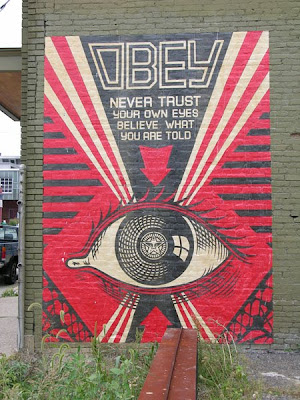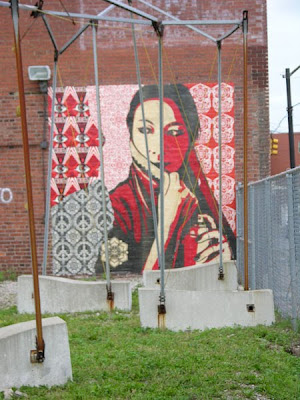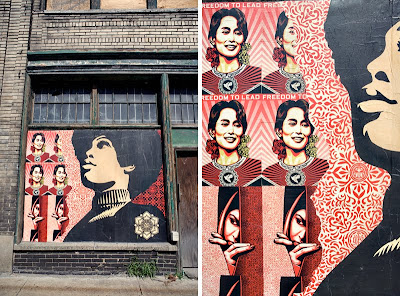Can you walk me through how a piece comes into being from idea to finished piece.
Let’s see, right now I’m reading “What Painting Is?” by James Elkins and its generating this idea that I want to take various paintings from art history and have them all be melting together, both breaking back down into their chemical makeup, or look like it anyway, then all the color and material mixing together and starting to take a new form, as if the ultimate meaning of the images can be gleaned out by melting and fusing them together. I can’t really picture what this will look like in my head so I’ll usually start with photocopying images from books and cutting and pasting them together and drawing doodles and then the answer might lie more in the process. I can plan which images and how they collide, but I probably won’t come up with the new form it creates until I start working and it starts to form through the process. That is how the work is going these days anyway. Sometimes it’s much more preplanned. Like I had an idea to make a huge early American realist landscape painting being attacked by a woodpecker who was tricked by the realism. But also have it look like machine gunfire blasted the painting from farther away when you see it at first glance and don’t notice the woodpecker. Woodpeckers look for infestations so it implies a level of self-destruction within the American landscape. This was more straight-forward to execute although the process of making the piece added more richness. I got the idea from 2 articles in a newspaper on the same page: there was an article on the war in Iraq and a photo of a tank in Iraq shot through with holes like swiss cheese and below the image was another article on a sighting of a rare woodpecker and it gave me the idea.

It’s been a long windy process, that seems to circle around continually, like the snake eating its tail. I’ve always had a strong interest in place, memory, artifact, and make-believe. I grew up in a colonial style house that was built in the late 60s, so we had some faux early American artifacts like a rifle over the fireplace, bedwarmer, Paul Revere tea set and American-ish landscape paintings on the walls, along with framed reproductions of famous paintings that were made to look like real paintings. I loved thinking about these scenes and artifacts as my personal history even though it wasn’t true. My father would always point at the large beams in the ceiling and explain to people how they were cleverly made with many 2x4s stacked together and roughed up so they look just like the original beams would have. I think I hooked onto his delight in the clever copy. We were also never allowed to tack anything to the walls of our bedroom or bend or write on pages in books. I shared a bedroom with my sister and the furniture set was too large for the room so we were packed in there and couldn’t even shut the door. I’d just lie on the bed and imagine writing in all the books and on the walls and breaking the furniture into smaller pieces so we had more room. I think making art and making paintings and breaking them and trying to transform them comes from this strong impulse to touch forbidden things and explore them with a creative passion. To sort of eek out the essence of the materials and meaning. I remember once my sister made a human-like head of Kleenex and glue that looked like a real head and she would carry it around with her on a stick. One day when she left it unattended, our dog attacked it and we found it strewn all over the house and I thought it was brilliant. My father’s a doctor so we would hear about a lot of gory accidents from his reports back from the emergency room so I have a strong sense of the fragility of things and like the rest of my family, I developed a dark sense of humor as a way to cope with the anxiety generated by hearing about bodies falling apart.
How do you decide what materials to work with-- how to turn a 2-d painting into a 3-d sculpture that comes off the wall?
I use materials that are easy for me to manipulate, so they tend to be materials I learned to use as a kid, like cardboard, papermache, tape, wood, wire, glue. Now I’m working on a public project for the Highline that has to be outdoors so I’m working with a fabricator that is translating the work into the best materials for that such as aluminum rod, fiberglass, and epoxy.
What artists, books, or other sources do you look to for ideas and inspiration?
I find inspiration in Magical Realist writers like Octavio Paz and Jose Saramago. How they start the reader off on a totally probably path of the story and somehow when the unbelievable starts to happen, it seems probable. These transitions are beautiful and strange. Oh and I’ve been thinking about Magritte, his way of showing the concealed and the revealed at the same time, these impossible juxtapositions that he makes seem possible and the poetry in the “seaming” together of contrasts. Lately for inspiration I’ve been looking at books on crystals and minerals, bonsai, images of the earth from space, and images of space from the hubble telescope. I also went and looked at the Georgia O’Keefe abstraction show the other day to generate ideas for these abstract forms I want to make based on atmospheric conditions. I’m interested in the sublime in painting and how to transform the 2-d painting into a more abstract form and image, making the transformation of the painting itself a sublime occurrence.
Did you always want to be an artist? and how did your career develop when you were first starting out?
I remember when I was really young, I wrote down two career options for myself. One was an artist and one was a writer. I remember practicing my signature on the paper and then putting it away in a drawer. I still think about being a writer. I used to make drawings, paintings, and crafty projects all the time when I was a kid, in addition to writing detective/murder mysteries usually involving ESP. I didn’t really take art in high school because I figured artists must be REALLY good, but in college I took an art class as a lark my junior year and switched my major to studio art much to my parents dismay who were paying my tuition. I then went and did another undergrad in illustration in San Francisco, did that for a bit and didn’t like it and finally went back to graduate school for an MFA at the Art Institute of Chicago. When I graduated I moved to NY and just started applying for everything and was lucky that I got presented many opportunities for free studio space and site-specific installations. I was nominated for a grant and a gallery saw the list of nominees and took an interest in my work. They (Guild & Greyshkul) then offered me a solo show and things went well and we worked together for about 4 years until they closed this past January. Lately I’ve been thinking about wanting to be a writer again and have been writing my own magical realist short stories that tend to veer into the gothic. One story is sort of a retake on Frankenstein, where the artist cuts off her arm in order to have it keep producing in the studio at night while she goes home and sleeps. As you can imagine, things go awry quickly.
What is the most interesting and engaging part about making your work?
I love when I am in the middle of it and things seem to take shape in front of my own eyes, as if someone else was doing it. It’s such an exciting feeling when it seems as if I’m discovering and creating something totally new for myself.
What do you least enjoy about making your work--but you've gotta do it?
Plenty of time the work seems like pure drudgery, once the idea and form is set and there is just straight execution. If I had more money I’d get a team of assistants to do all the labor. And have them clean and organize my studio, it tends to be in disarray most of the time. I also don’t enjoy figuring out and buying materials, packing and shipping work, and trying to keep galleries and curators from figuring out my ideas and work that has changed since we last spoke about the show.
What is your studio routine? several project at once? Do you spend time doing research, collecting source materials and ideas?
My studio routine is all over the place. There’s always times when I’m sketching ideas, or looking through and reading books, making models, sleeping, trying to organize the mess I made the day before, talking to whoever is sitting by the refrigerator, picking through the garbage for something I regretted throwing away, etc. There are usually a few projects going on at once and I will work back and forth, trying to give a piece a rest when I can’t seem to figure it out.
What projects are you working on now?
I just finished up some work for a show in Portugal in the spring and finished a public project for the Highline that was installed last week. And I am just about to get started on work for my first solo show at my new gallery in the lower east side, Nicelle Beauchene Gallery.
What do you enjoy doing when you're not in the studio?

What philosophy or words do you live by?
Valerie has had solo exhibitions at Museum 52 in London, England, the Museum of Contemporary Art Chicago and Guild & Greyshkul Gallery in New York, among others. Her many group exhibitions in New York City include shows at the Brooklyn Museum of Art, Artists Space, The Drawing Center, White Columns and PS1. She is the recipient of awards from the Rema Hort Mann Foundation, the Louis Comfort Tiffany Foundation, and the Illinois Art Council. Additionally, she has participated in residencies at the Marie Walsh Sharpe Space Program, PS 122 Space Program, and Smack Mellon Artist’s Studio Residency, among others. Hegarty holds a MFA from the School of the Art Institute of Chicago, a BFA from San Francisco’s Academy of Art College, and a BA from Middlebury College.
Valerie Hegarty is represented by: Nicelle Beauchene in NY and Museum 52 in London
View more information on Valerie's installation on the High Line in NYC.
















































